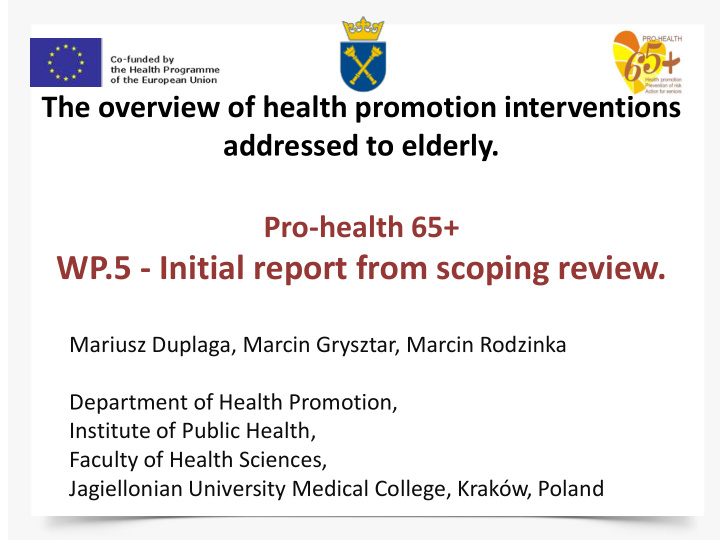



The overview of health promotion interventions addressed to elderly. Pro-health 65+ WP.5 - Initial report from scoping review. Mariusz Duplaga, Marcin Grysztar, Marcin Rodzinka Department of Health Promotion, Institute of Public Health, Faculty of Health Sciences, Jagiellonian University Medical College, Kraków, Poland
Scoping review
Secondary evidence Stage I stage II stage Main objectives definition of domain assessment of effectiveness identification of gaps in of interventions specific evidence according to type and target area Methods scoping review focused systematic reviews Type of evidence secondary evidence primary sources Main sources systematic reviews original quantitative studies Additional existing up-to-date qualitative studies sources recommendations and guidelines project results
Key concepts • health promotion “the process of enabling people to increase control over, and to improve, their health” – [Ottawa Charter 1986] • prevention “measures not only to prevent the occurrence of disease, such as risk factor reduction, – but also to arrest its progress and reduce its consequences once established” [Nutbeam 1998] • prevention vs. health promotion • interventions • outcomes - outcome model proposed by The International Union for Health Promotion and Education (IUPHE): health & social outcomes – intermediate health outcomes – health promotion outcomes – health promotion actions –
Scoping review - objectives • description of the domain • understanding the scope of interventions and activities • identification of interventions of confirmed effectiveness • discovery of existing gaps in evidence
Main assumptions • guiding definition of health promotion and classification of interventions • search strategy in relation to general areas of interventions • inclusion of health promotion and disease prevention interventions • post-search classification of interventions • selection of primary prevention interventions • subjects with medical conditions as targeted audiences • screening • social support/care • medical domain/condition
Search strategy Population Intervention/interest Comparison Outcome Elderly Health promotion* Systematic review Effectiveness terms used in the extended terms used in the first pilot phase of search second phase of search Elderly “Health promotion” “Health education” “Systematic Effectiveness • • • • • Senior Prevention “Health literacy” review” Efficacy • • • • Senioral Intervention “Health “Meta analysis” Efficiency • • • • • Elders Interventions communication” “Meta-analysis” Impact • • • • Elder Campaign “Health advocacy” Metaanalysis Evidence • • • • • “Senior citizen” Campaigns “Community advocacy” Outcomes • • • • “Old age” “Health programme” “Social campaign” • • • “Old people” “Health program” “Social campaigns” • • • Seniors “Social support” “Health coaching” • • • “Advanced age” “Social care” “Environmental change • • • Geriatric “Social intervention” strategies” • • Aged Screening “Healthy environment” • • • Ageing Preventive “Community • • • Aging Prophylaxis mobilization” • • Nutrition “Behavior modification” • • “Physical activity” Prophylaxis • • Habits Screening • • Addiction “Primary prevention” • • “Health screening” • “Support groups” • “Social network” • “Social gathering” • “Health changes” •
Inclusion & exclusion criteria Inclusion criteria Exclusion criteria health promotion and/or related interventions related to (medical) • • interventions (primary treatment or physiotherapy prevention, screening, social interventions focused on • support/care) treatment of consequences of secondary sources (systematic medical conditions • reviews, meta-analysis) age of target group <55 years old • age of target group 55+ or 65+ or publication period – before 2000 • • at least including subjects 65+ published in other language than • publication period 2000 – 2015 English • published in English effectiveness of intervention not • • described effectiveness of addressed • interventions
PRISMA Diagram
Dimensions of classification and data collection tool • year of publication • age of targeted audience • sex of targeted audience • targeted area of interventions • medical domain/condition, if applicable • level of public health pyramid • type of health intervention according to Issel • type of health promotion intervention according to McKenzie et al. • the use of technologies for intervention delivery • types of studies included in the systematic review • initial assessment of the effectiveness
Description of health promotion interventions – 2nd phase • detailed information on types of studies included in the analysis • types of outcomes according to Outcome Model for health promotion • detailed analysis of interventions • reliability of systematic review • quality assessment of systematic review (R- AMSTAR)
Scoping review – initial results
The numbers of retrieved systematic review according to the year of publication
The numbers of systematic reviews classified as belonging to four main general areas of intervention. 220 240 175 180 120 33 60 33 0 health promotion prevention screening social support/care
The numbers of systematic reviews classified according to main issues targeted by analysed interventions
Type of interventions according to McKenzie et al.
Summary • The report aimed at obtaining a view of the landscape of interventions in the domain of health promotion • Retrieved systematic reviews were classified according to several dimensions • 335 systematic reviews
Summary • behaviour modification and health education were two the most common types of interventions (n=86 and n=85, respectively) classified as a health promotion interventions • 46% of analyzed interventions were effective • of 48% effectiveness was low or the results were ambiguous • no effectiveness was reported in 6% of reviews
Future work • desription of secondary evidence, focused only on systematic reviews classified to health promotion as general area of intervention • recommendations on health promotion interventions effective in relation to older adults and elderly • gaps in secondary evidence – systematic review
Workpackage contribution Author Work contribution Mariusz Duplaga study design, analysis of results, edition of the Report Marcin Grysztar search strategy, classification and description of retrieved papers Marcin Rodzinka classification and description of retrieved papers Agnieszka Kopeć classification and description of retrieved papers
Recommend
More recommend